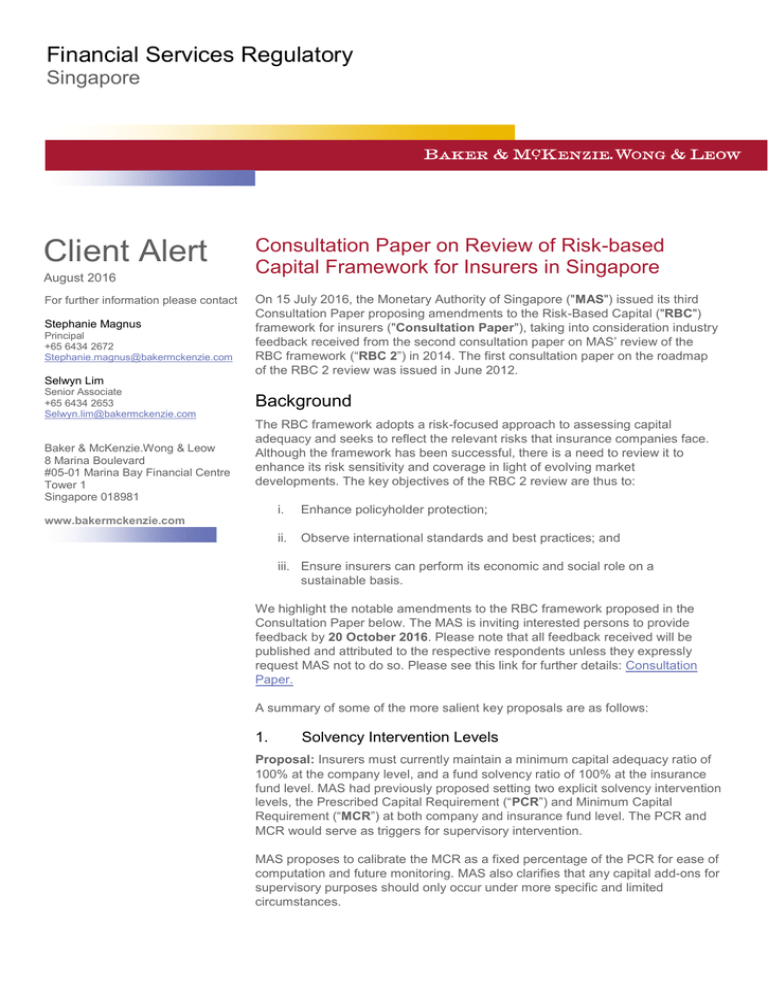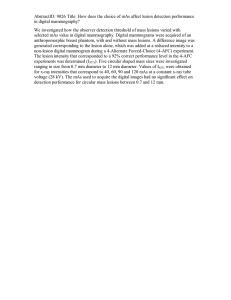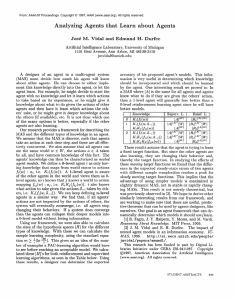
Financial Services Regulatory
Singapore
Client Alert
August 2016
For further information please contact
Stephanie Magnus
Principal
+65 6434 2672
Stephanie.magnus@bakermckenzie.com
Consultation Paper on Review of Risk-based
Capital Framework for Insurers in Singapore
On 15 July 2016, the Monetary Authority of Singapore ("MAS") issued its third
Consultation Paper proposing amendments to the Risk-Based Capital ("RBC")
framework for insurers ("Consultation Paper"), taking into consideration industry
feedback received from the second consultation paper on MAS’ review of the
RBC framework (“RBC 2”) in 2014. The first consultation paper on the roadmap
of the RBC 2 review was issued in June 2012.
Selwyn Lim
Senior Associate
+65 6434 2653
Selwyn.lim@bakermckenzie.com
Baker & McKenzie.Wong & Leow
8 Marina Boulevard
#05-01 Marina Bay Financial Centre
Tower 1
Singapore 018981
Background
The RBC framework adopts a risk-focused approach to assessing capital
adequacy and seeks to reflect the relevant risks that insurance companies face.
Although the framework has been successful, there is a need to review it to
enhance its risk sensitivity and coverage in light of evolving market
developments. The key objectives of the RBC 2 review are thus to:
i.
Enhance policyholder protection;
ii.
Observe international standards and best practices; and
www.bakermckenzie.com
iii. Ensure insurers can perform its economic and social role on a
sustainable basis.
We highlight the notable amendments to the RBC framework proposed in the
Consultation Paper below. The MAS is inviting interested persons to provide
feedback by 20 October 2016. Please note that all feedback received will be
published and attributed to the respective respondents unless they expressly
request MAS not to do so. Please see this link for further details: Consultation
Paper.
A summary of some of the more salient key proposals are as follows:
1.
Solvency Intervention Levels
Proposal: Insurers must currently maintain a minimum capital adequacy ratio of
100% at the company level, and a fund solvency ratio of 100% at the insurance
fund level. MAS had previously proposed setting two explicit solvency intervention
levels, the Prescribed Capital Requirement (“PCR”) and Minimum Capital
Requirement (“MCR”) at both company and insurance fund level. The PCR and
MCR would serve as triggers for supervisory intervention.
MAS proposes to calibrate the MCR as a fixed percentage of the PCR for ease of
computation and future monitoring. MAS also clarifies that any capital add-ons for
supervisory purposes should only occur under more specific and limited
circumstances.
MAS further proposes to moderate the calibration of risk requirements to achieve
a Value at Risk ("VaR") of 99.5% confidence level at the company level to
address industry concerns of overcapitalisation.
An insurer whose capital falls below its PCR must submit to MAS a plan to
restore its capital position within a specified timeframe. MAS will determine the
timeframe for submission of the capital restoration plan and the capital restoration
period on a case-by-case basis.
2.
Valuation of Assets and Liabilities
A.
Discounting Approach for Policy Liabilities
Proposal: Life insurers are currently required to calculate their policy liabilities for
non-participating policies, non-unit reserves of investment-linked policies, and the
minimum condition liability of participating funds using a prospective discounted
cash flow method and the risk-free discount rate. MAS had previously proposed
transiting from the current long-term risk-free discount rate ("LTRFDR") to the use
of the 30-year Singapore Government Securities ("SGS") yield (i.e. keeping the
yield flat at the prevailing yield of 30-year SGS for periods of 30 years and above)
in determining the risk-free discount rate.
MAS now proposes to explore using an extrapolated yield curve to determine the
risk-free discount rate in light of industry concerns that the 30-year SGS bond
market was not deep and liquid enough.
MAS further proposes, in relation to general insurance business, that no
discounting will be required for liability durations of one year or less, or for liability
durations of more than one year if the impact is not deemed to be material.
Where discounting is carried out, the approach will be the same as for life
business for both SGD and non-SGD denominated liabilities.
B.
Introduction of Matching Adjustment ("MA") and Illiquidity Premium ("IP")
Proposal: Insurers are exposed to short-term volatility in bond prices when they
need to sell bonds at unexpected times, as well as the risk of default and
downgrade of the bonds. MAS previously proposed introducing a MA mechanism,
which was a parallel upward adjustment applied to the risk-free discount rate
used in valuing eligible policy liabilities for life business. The MA can be applied
where certain conditions are met ("eligibility criteria").
MAS proposes the following key refinements to the eligibility criteria of the MA:
i.
Allow the use of USD bonds to match SGD denominated liabilities;
ii.
Remove the cash flow matching requirement for each future year of
projection of the liabilities;
iii. Allow the use of callable bonds;
iv. Predictability test to be applied on a portfolio basis; and
v.
Allow positive net cash flows to be rolled forward to meet deficits in later
years.
MAS also proposes not differentiating the loss given default ("LGD") according to
the respective credit rating of the underlying bond in determining the cost of
default, and to maintain the same spread for default and downgrade for USD and
SGD products.
2 | Financial Services Regulatory Client Alert
MAS further proposes introducing an IP to the risk-free discount rate for eligible
life business, and will provide detailed specifications to life insurers within one
month after the issuance of the Consultation Paper.
3.
Components of Required Capital
Proposal: The RBC framework requires insurers to hold capital (“Total Risk
Requirements or TRR”) against their risk exposures. The TRR comprises of
three broad components.
A.
Component 1 ("C1") Requirements
Proposal: C1 of the TRR relates to insurance risks undertaken by insurers, and
is determined (for general business) by applying specific risk charges on an
insurer’s premium and claims liabilities, or (for life business) by applying specific
risk loadings to key parameters affecting policy liabilities such as mortality,
morbidity, expenses and policy termination rates.
For life business, MAS proposes to accord more diversification benefits for C1
requirements for life business by expanding the correlation matrix to combine
certain, but not all, the underlying risk requirements under C1. It also proposes to
apply certain permanent increases to the best estimate risk assumptions in
relation to each C1 risk requirement.
For general business, MAS seeks comments on whether other types of risk (e.g.
lapse) should be considered for C1 requirements, in addition to premium liability,
claim liability and insurance catastrophe risk requirements.
B.
Component 2 ("C2") Requirements
Proposal: C2 of the TRR relates to risks inherent in an insurer's asset portfolio,
such as market risk and credit risk.
MAS had previously proposed accounting for diversification benefits implicitly
within the calibration of each C2 requirement. MAS now proposes to introduce an
explicit correlation matrix for C2 requirements. The C2 requirements will also
have to be re-calibrated.
Numerous other changes are also proposed in respect of the C2 risk
requirements, e.g. changes relating to the equity investment risk requirement,
interest rate mismatch risk requirement, credit spread risk requirement, property
investment risk requirement, foreign currency mismatch risk requirement, and
counterparty default risk requirement.
For example:
(i)
whereas MAS previously proposed to introduce three distinct risk
categories under the C2 equity risk requirement: (i) listed in Singapore /
developed markets (40%); (ii) listed in other markets (50%); and (iii) unlisted
equity (including private equity and hedge funds (60%). MAS is now proposing to
moderate the calibration of the equity risk requirement, and reduce the C2 equity
risk requirement categories as follows: (i) listed in developed markets (40%); and
(ii) other equities (50%);
(ii)
in relation to the credit spread risk requirement under RBC 2, MAS
proposes to moderate the credit spread shocks further to make it more
3 | Financial Services Regulatory Client Alert
comparable with other jurisdictions’ calibrations. MAS has also smoothened the
factors to ensure a gradual reduction in risk requirements;
(iii)
MAS proposes having one broad category for the property risk
requirement (at 30%, and no distinction made as to the risk characteristics of
different property types such as local and overseas, residential, office and retail),
and, in the case of CIS invested in property assets for investment purposes, to
adopt a look-through approach. Where a look-through approach is not adopted, a
flat risk charge of 55% will apply.
Please refer to the Consultation Paper for further detail on the proposed changes
to the C2 requirements.
C.
Component 3 ("C3") Requirements
Proposal: C3 of the TRR relates to asset concentration risks in certain types of
assets, counterparties or groups of counterparties.
In practice, insurers try to diversify assets amongst the counterparties to minimise
the C3 requirement. As such, this risk requirement is typically negligible, if not
absent. To this end, MAS does not expect to impose further requirements (e.g.
hard limits like for banks) to deal explicitly with concentration risk.
Accordingly, MAS proposes to remove the C3 risk requirements and instead
deduct asset holdings which exceed prescribed concentration limits from the
financial resources. MAS is prepared to explore more latitude in how the
concentration limits are being applied, without compromising prudential concerns.
D.
Operational Risk Requirements
Operational risk refers to the risk of loss arising from complex operations,
inadequate internal controls, processes and information systems, organisational
changes, fraud or human errors, or unforeseen catastrophes including terrorist
attacks. There is currently no explicit risk charge for operational risk under the
RBC framework. MAS had previously proposed a formula to quantify operational
risk in the second consultation paper.
MAS proposes to moderate the formula for the operational risk requirement in
light of industry feedback. In addition, to avoid penalising growth, MAS has
included a threshold to capture only excessive growth as well as retaining the cap
of 10% of the TRR.
4.
Components of Available Capital
The amount of capital available to meet the TRR is referred to as financial
resources. Financial resources at the company level comprises of Tier 1
resources, Tier 2 resources and the allowance for provision for non-guaranteed
benefits.
A.
Consistency with Capital Framework for Banks
Proposal: Under the capital framework for banks, Tier 1 of a bank's available
capital includes CET1 capital, which represents the highest quality component of
capital.
MAS proposes to introduce a new category of CET1 capital for licensed insurers
incorporated in Singapore consisting of the surplus of insurance funds (excluding
Participating Fund), surplus account of the Participating Fund, surplus of
overseas branch operations, paid-up capital and retained earnings.
4 | Financial Services Regulatory Client Alert
MAS will proceed with previously proposed amendments in the classification and
definition of the available capital components for insurers.
MAS also proposes to adopt the following changes in the classification and
definition of available capital components for insurers:
i.
Rename Approved Tier 1 capital as Additional Tier 1 ("AT1") capital;
ii.
Irredeemable and non-cumulative preference shares, currently a
standalone item under Tier 1 resource, will be subsumed under AT1
capital, subject to meeting certain relevant criteria;
iii. Rename Qualifying Tier 2 capital as Tier 2 capital; and
iv. Irredeemable and cumulative preference shares, currently a standalone
item under Tier 2 Resource, will be subsumed under Tier 2 capital,
subject to meeting certain relevant criteria.
There are currently limits on the amount of certain Tier 1 or Tier 2 capital
components that can be recognised as financial resources. The proposed
reclassification requires such limits to be amended to ensure that a prudent level
of available capital is held in higher quality capital. MAS proposes to impose a
floor of 60% of TRR for CET1 capital, and a floor of 80% of TRR on the Tier 1
capital. MAS will also correspondingly reduce the threshold for the principal loss
absorption feature proposed in the second consultation paper to 65% of the TRR.
B.
Recognition of Reinsurance Arrangements Arranged by Head Office and
with Downstream Entities
MAS proposes to continue to recognise reinsurance arrangements where risks
written by the Singapore branch are included in the head office’s reinsurance
arrangements with third party reinsurers, regardless of whether the branch has a
legal right to receive the recoveries directly from the third party reinsurers, subject
to the following safeguards:
(i)
MAS proposes that where reinsurance recoverables have already been
paid from third party reinsurers, pending distribution from the head office, the
amount would be subject to a risk charge that is dependent on the credit rating of
the head office for the initial ageing period of 90 days. After the end of the ageing
period, a 100% risk charge would be levied.
(ii)
MAS further proposes, for cases where the Singapore branch does not
have the legal right to receive the recoveries directly from the third party
reinsurers or is not a named party to the contract, for the head office to provide a
written confirmation that the Singapore branch is covered within its reinsurance
arrangements with third party reinsurers. The confirmation should also contain
other relevant details pertaining to the arrangements such as how reinsurance
recoverable to the branch will be determined.
Insurers may also purchase reinsurance protection from its subsidiary or, for
branches, a subsidiary of its head office. MAS is prepared to recognise the
arrangements with such downstream entities as reinsurance, but requires
safeguards such as collaterals and letter of credit for the benefit of the ceding
insurer before recognition can be given.
5 | Financial Services Regulatory Client Alert
5.
Treatment of OIF for Reinsurers
Licensed reinsurers are currently either subject to a simplified solvency regime (in
the case of locally incorporated reinsurers) or exempted from capital or solvency
requirements (in the case of reinsurance branches).
MAS had previously proposed that only the OIF of locally-owned locally
incorporated reinsurers be subject to the full RBC 2 requirements. The OIF of
foreign-incorporated licensed reinsurers (i.e. reinsurance branches) would remain
exempt from the solvency requirements and the OIF business of foreign-owned
locally incorporated reinsurers would remain under the current simplified solvency
requirement.
MAS will clarify in its rules that for locally incorporated reinsurers, as long as the
locally incorporated reinsurer is headquartered in Singapore (i.e. ultimate parent
is incorporated in Singapore), the OIF will be subject to RBC 2.
6.
Quantitative Impact Study ("QIS")
The QIS has been designed to gather information to help evaluate the impact of
the revised RBC 2 proposals.
All insurers (with the exception of captives, Lloyd’s insurers and marine mutuals)
will be required to conduct the QIS 2. This will allow the insurers to understand
the impact of the revised RBC 2 proposals on their capital positions and highlight
any implementation issues experienced in conducting the QIS 2.
The consultation period ends on 20 October 2016. Please contact us if you have
any comments or queries.
©2016 Baker & McKenzie.Wong & Leow. All rights reserved. Baker & McKenzie.Wong & Leow is a member of Baker & McKenzie International, a Swiss Verein with member law firms around the world. In accordance
with the common terminology used in professional service organizations, reference to a “partner” means a person who is a partner, or equivalent, in such a law firm. Similarly, reference to an “office” means an office of
any such law firm.
This may qualify as “Attorney Advertising” requiring notice in some jurisdictions. Prior results do not guarantee a similar outcome.
6 | Financial Services Regulatory Client Alert


